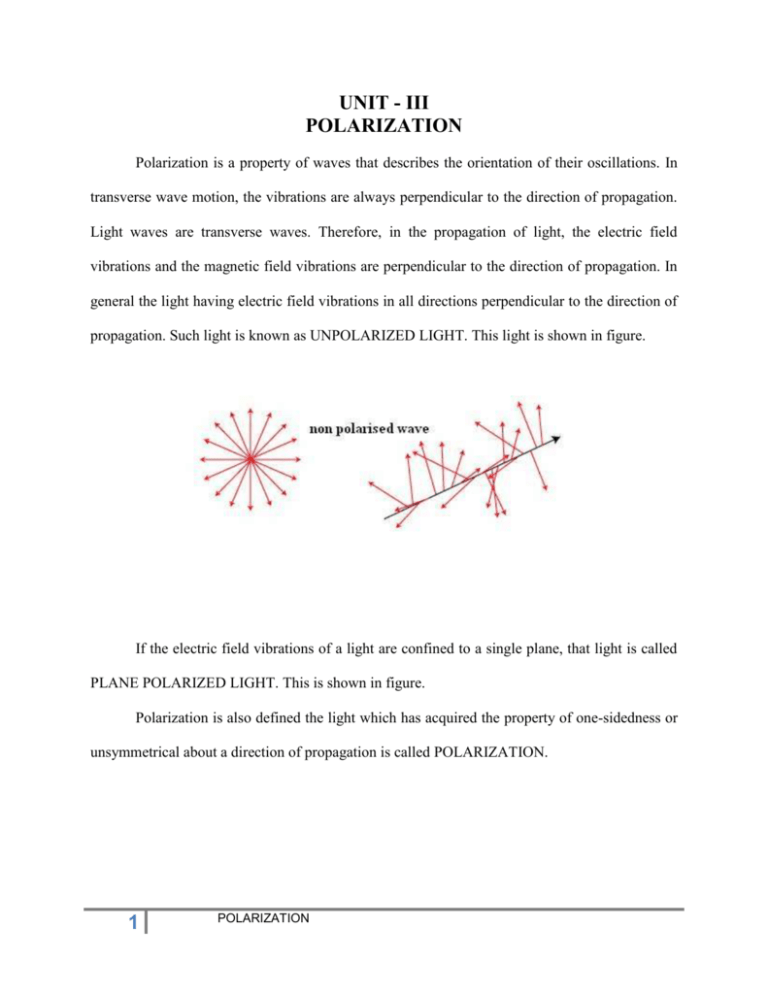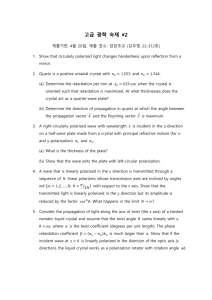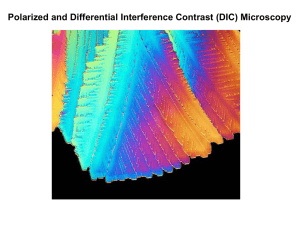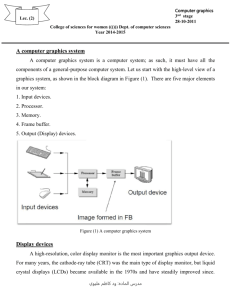File - Pragati fast updates
advertisement

UNIT - III POLARIZATION Polarization is a property of waves that describes the orientation of their oscillations. In transverse wave motion, the vibrations are always perpendicular to the direction of propagation. Light waves are transverse waves. Therefore, in the propagation of light, the electric field vibrations and the magnetic field vibrations are perpendicular to the direction of propagation. In general the light having electric field vibrations in all directions perpendicular to the direction of propagation. Such light is known as UNPOLARIZED LIGHT. This light is shown in figure. If the electric field vibrations of a light are confined to a single plane, that light is called PLANE POLARIZED LIGHT. This is shown in figure. Polarization is also defined the light which has acquired the property of one-sidedness or unsymmetrical about a direction of propagation is called POLARIZATION. 1 POLARIZATION In both these figures the direction of propagation is normal to the plane of the paper. TYPES OF POLARISATION AND THEIR REPRESENTATION: Linearly, Circular and Elliptical polarization: Experimentally, it is found that the light exhibits the following three types of polarization. 1. Plane polarized light 2. Circularly polarized light 3. Elliptically polarized light. 1. Plane Polarized light: If the electric component of light passing through the medium vibrates only along a single direction perpendicular to the direction of propagation, the wave is said to be plane polarized or linearly polarized. This is shown in figure1. The electric vector E can be resolved into two rectangular components Ex and Ey. Therefore, the transverse electric vector may be regarded as superposition of two mutually perpendicular electric fields. Thus E=iEx+jEy 2 POLARIZATION Thus the vector E or linearly polarized is the superposition of two mutually perpendicular waves having zero phase difference. This is shown in figure. 2. Circularly polarized light: If two electric vectors Ex and Ey having same magnitude but vibrating in two mutually perpendicular with phase difference π/2 radians super impose the magnitude of the resultant vector E remains constant about the direction of propagation such that it goes on sweeping a circular helix in space during the course of propagation. Such light wave is called circularly polarized light. This is shown in figure2 If we imagine that we are looking into the light source and observe the rotation of the light vector E, we observe that the tip of light vector E traces a circle on the plane perpendicular to the ray direction. If rotation of the vector tip is clockwise, the light is said to be right circular polarized. However, If it is rotates anticlockwise, the light is said to be left circularly polarized. 3. Elleptically polarized light: If the two electric vectors Ex and Ey having unequal amplitude vibrating in two mutually perpendicular planes superimpose at phase which differ in π/2 radians, the magnitude of the resultant vector E changes with time and vector E sweeps a flattened helix in space. Such light wave is called elliptically polarized light. Shown in Fig3 Fig1 3 fig2 POLARIZATION fig3 DOUBLE REFRACTION: When a beam of ordinary unpolarized light is passed through a certain class of crystals like calcite or Quartz, the refracted beam is split up into two refracted rays. This phenomenon is known as “double refraction”. The crystals showing this phenomenon are known as double “refracting crystals”. One of the refracted beams is found to obey the Snell’s law and is called the ordinary ray (O-ray). The other refracted beam does not obey Snell’s law and is called the extraordinary ray or E-ray. Both the rays are plane polarized and their vibrations are perpendicular to each other (as shown in Fig.) Upolarized light 4 POLARIZATION Ordinary and Extraordinary rays: The ordinary ray travels in the crystal with same velocity in all direction. Therefore, the refractive index for O-ray is constant. The extraordinary rays travels in the crystal with a velocity that varies with direction. Thus the refractive index for these rays varies with direction. The quantities μ0 and μe are called the principal refractive indices for the crystal. The ordinary ray has the same velocity in all directions and hence its wavefront is spherical. Extraordinary ray has different velocities in different directions and hence its wavefront is ellipsoid. In certain crystals, the ellipsoid lies outside the sphere i.e. the extraordinary wavefront travels faster than ordinary wavefront except along optic axis. For such crystals μ0 > μe . These crystals are known as negative crystals. Example Calcite and tourmaline. In some other crystals the sphere lies outside ellipsoide i.e. the velocity of ordinary wavefront is greater than extraordinary wavefront except along the optic axis. For such crysgtals μ0 < μe . These crystals are known as positive crystals. Example Quartz. 5 POLARIZATION The difference between the refractive index of O-ray and E-ray is called birefringence ∆μ= μ0 −μe The quantity ∆μ is maximum in the direction perpendicular to the optics. Along the optics axis the quantity ∆μ=0 If ∆μ is positive, the crystal is called negative If ∆μ is negative, the crystal is positive. Both O-ray and E-ray are linearly polarized. They are polarized in mutually perpendicular direction. The vibrations of O-ray is perpendicular to the principle section and Eray vibrations are parallel to the principle section. Uniaxial Crystals: Crystals in which there is only one direction of optic axis are known as un axial crystal Example: calcite and quartz. Biaxial Crystals: Crystals in which there are two optic axes corresponding to both the blunt corners are known as biaxial crystals. Example mica gypsum topaz. NICOL PRISM: Principle: When an unpolarized light is transmitted through a calcite crystal, it splits in ordinary and extra-ordinary ray beams. These beams are completely plane polarized with vibrations 6 POLARIZATION perpendicular to each other. If by some means one beam is eliminated then the emergent beam from calcite crystal will be plane polarized light. This is achieved by using a Nicol prism. Working: Nicol prism is constructed from calcite crystal whose length is three times as its width. The crystal is cut in two pieces along a diagonal. Canada balsam cements the two cut surfaces together. Canada balsam is a transparent substance for light. The refractive index of Canada balsam lies between the refractive indices for the ordinary and extra-ordinary rays for calcite. For sodium light the refractive indices are μo = 1.658, μcanada balsam = 1.55, μe = 1.486. When a beam of unpolarized light enters into Nicol prism, it is doubly refracted into ordinary plane polarized light and extra ordinary plane polarized light. From the values of refractive indices, it is clear that Canada balsam acts as a rarer medium for an O-ray and denser medium for an E-ray. Therefore, there exists a critical angle of refraction for the O-rays at calcite Canada balsam surfaces but not for the E-rays. Therefore there exists a critical angle of refraction 7 POLARIZATION for the O-rays at calcite-canada balsam surface and but not for the E-rays. Under these conditions, the ordinary ray is completely reflected at calcite-Canada balsam surfaces and is absorbed by the tube as shown in Fig. The value of critical angle φc = = 690 The extra-ordinary ray is not totally reflected because it is traveling from a rarer to a denser medium. Thus, only extra-ordinary ray is transmitted. Since extra-ordinary rays are plane polarized, the light emerging from Nicol prism is plane polarized. Limitations: To obtain plane polarizeds light, the incident light should be confined within an angle of 140 on either side of the incident normal. Nocol as polarizer and analyser: Two Nicols lined up one behind the other are often used in optical microscopes for studying optical properties of the crystal. The first Nicol, which is used to produce the plane polarized light, is called the polarizer and the second Nicol, which is used to test the light, is called the analyzer. In the parallel position light from the polarizer passes on through the analyzer shown in figure (a) . Upon rotating the analyzer through 900 as shown in figure no light is transmitted. In this case, E- ray in the second Nicol is totally reflected. In this situation the both Nicols are crossed shown in fig(b). 8 POLARIZATION RETARDATION PLATES (OR QUARTER WAVE PLATE AND HALF WAVE PLATE): A retardation plate resolves a polarized light beam into two orthogonal components, retards the phase of one component relative to the other and the recombines the two to form a single beam with new polarization. Two types of retardation plates are used in optical instruments. 1. Quarter wave Plate 2. Half wave Plate 1. QUARTER WAVE PLATE: If the thickness of the crystal is such that it introduces a phase difference of /2 or a path difference of /4, then the light emerging from this crystal is circularly polarized. Such a crystal is called Quarter wave plate 9 POLARIZATION Thickness of Quarter wave plate; t = 4 o e 2. HALF WAVE PLATE: If the thickness of the crystal is such that it introduces a phase difference of or path difference /2, then the light emerging from this crystal is linearly polarized. A crystal plate of this type is called half-wave plate. Thickness of half wave plate t = 2 o e Where o and e are refractive indices of the crystal for ordinary and extra ordinary waves. Note: When the phase difference is 0, , 2, 3, 4, ………………….. or path difference is 0, , 2 , 3 , 4 ……the resultant light is a linearly polarized light. 2 2 2 2 If t is the thickness of the crystal and 0 , e refractive indices of the crystal for ordinary and extraordinary rays. t n 2 e o To produce linearly polarized the minimum thickness of the crystal is given by t 2 e o When the phase difference is /2, 3/2, 5/2, … or path difference is 0, resultant light is a circularly polarized light. 10 POLARIZATION , 3 , 5 …the 4 4 4 If t is the thickness of the crystal and 0 , e refractive indices of the crystal for ordinary and extraordinary rays. t 2n 1 4 e o To produce circularly polarized the minimum thickness of the crystal is given by t 11 POLARIZATION 4 e o









